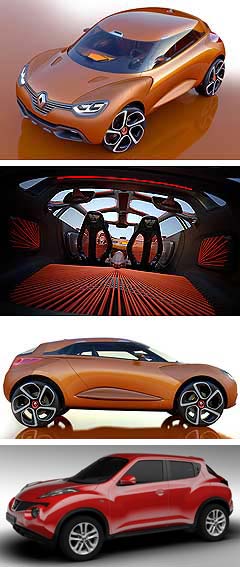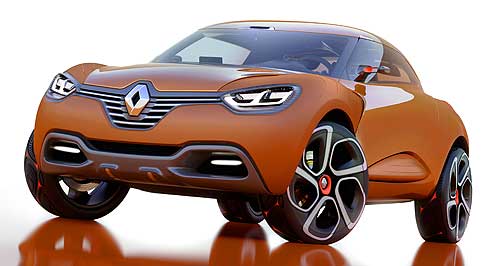Make / Model Search
Future models - Renault - CapturGeneva show: Renault previews forthcoming mini-SUVCaptur: Renault's SUV concept signals the French brands new styling theme. Crossover concept reveals future SUV and continues French brand’s new styling theme14 Feb 2011 RENAULT has unveiled its latest concept vehicle – a stylish new take on the SUV theme – ahead of next month’s unveiling at the Geneva motor show. And the company says that the front-wheel-drive Captur concept car is not just a styling exercise, but “previews a forthcoming road car”. It looks to be related to sister company Nissan’s Juke, which was launched globally last year but has yet to be confirmed for Australia. While Renault’s previous show car – the two-seater DeZir coupe that starred at the Paris show last October – was inspired by the passion of falling in love, the French company has taken the next stage of the human life cycle as its theme for the Captur SUV, that of two people exploring the world around them. Sharing a similar nose treatment and scissor-lift doors with the sleek coupe, the Captur is similarly striking, with voluptuous curves and a convertible roof. It is powered by a 1.6-litre twin-turbocharged diesel engine developed by Renault as part of its objective of being Europe’s leading automaker on CO2 emissions. This new ‘Energy dCi 160’ engine produces 118kW of power and 380Nm of torque from as low as 1750rpm, pushing the Captur from 0-100km/h in 8.0 seconds while delivering emissions of just 99g/km when paired with a dual-clutch transmission.  Top: Renault Captur concept. Bottom: Nissan Juke. Top: Renault Captur concept. Bottom: Nissan Juke.Renault is also heralding a new mechanical self-locking differential called RX2, which it claims improves traction at low speeds by transferring up to 100 per cent of the engine’s torque to the front wheel with the most grip in the event of losing traction. Captur also marks the debut of what Renault calls its ‘Visio-system’, which uses a forward-facing camera mounted at the top of the windscreen to provide driver-assistance functions. Captur was created under the direction of the company’s highly regarded Dutch design chief Laurens Van den Acker, who left Mazda less than two years ago to create a new styling direction for the French brand. He said the “simple, sensuous and warm” style demonstrated by both the DeZir and Captur would be progressively extended to future Renault car designs. Renault describes the crossover concept vehicle as having the fundamental design language introduced on the DeZir concept car, but with a more technical dimension – “more functional but still highly sensuous”. Exterior designer Julio Lozano said the main sources of inspiration were athletes and radical sports, with the aim of creating fluid curves to evoke movement and lightness while also displaying powerful and muscular all-terrain cues. “In designing Captur, I began with the image of a sprinter on the starting blocks, his muscles tensed, and the energy unleashed when the starting pistol is fired,” said Mr Lozano. “The design also references equipment such as helmets, gloves and other protective gear used in radical sports, combining high technology with sophistication and lightness.” As with DeZir, the SUV’s bold front has as its centrepiece a large Renault logo, set vertically against a dark surface to stand out. Other design features of the show car include matt-finished mudguards, LED indicator lights that run in a wave effect the whole length of the vehicle, massive 22-inch black and white wheels and a hard convertible roof that, once removed, reveals a carbon fibre framework. The vehicle’s orange colour continues into the cabin, which features fluorescent highlights, floating front seats attached to the centre console, a skin-like translucent material used to create the centre console, door casings and dashboard, and luminescent fibre ropes used throughout the passenger compartment and for the hammock-style seats. “The whole of the interior is designed around this network of stretched elastic ropes, which bring to mind the worlds of sailing or mountain climbing,” said interior designer Magali Gouraud-Borgers. “They use graphics and light to bring rhythm to the overall design and reinforce the dynamic feel of the vehicle while also ensuring a lighter feel inside the cabin. “The rear of the vehicle is a multipurpose area where the deck is lined with three layers of rope. The stretched cords are laid out in a way that allows items to be secured, thus providing a reconfigurable storage area.” Captur’s final trick is how it converts into a four-seater with seatbacks incorporating seatbelts and head restraints that pull out from the side of the car.  Read moreAll motor show Alfa Romeo Alfa Romeo Abarth Abarth Alpine Alpine Alpina Alpina Audi Audi Aston Martin Aston Martin BMW BMW Bentley Bentley Chery Chery Brabham Brabham Chrysler Chrysler Chevrolet Chevrolet Cupra Cupra Citroen Citroen DS DS Dodge Dodge Fiat Fiat Ferrari Ferrari Foton Foton Ford Ford Great Wall Great Wall FPV FPV Haval Haval GWM GWM Honda Honda Holden Holden Hummer Hummer HSV HSV Infiniti Infiniti Hyundai Hyundai Jaguar Jaguar Isuzu Isuzu Kia Kia Jeep Jeep Land Rover Land Rover Lamborghini Lamborghini Lexus Lexus LDV LDV Mahindra Mahindra Lotus Lotus Mazda Mazda Maserati Maserati Mercedes-AMG Mercedes-AMG McLaren McLaren MG MG Mercedes-Benz Mercedes-Benz Mitsubishi Mitsubishi Mini Mini Opel Opel Nissan Nissan Peugeot Peugeot Pagani Pagani Proton Proton Porsche Porsche Renault Renault Ram Ram Rover Rover Rolls-Royce Rolls-Royce Skoda Skoda Saab Saab SsangYong SsangYong Smart Smart Suzuki Suzuki Subaru Subaru Toyota Toyota Tesla Tesla Volvo VolvoMotor industry news |
Click to shareAll motor show Alfa Romeo Alfa Romeo Abarth Abarth Alpine Alpine Alpina Alpina Audi Audi Aston Martin Aston Martin BMW BMW Bentley Bentley Chery Chery Brabham Brabham Chrysler Chrysler Chevrolet Chevrolet Cupra Cupra Citroen Citroen DS DS Dodge Dodge Fiat Fiat Ferrari Ferrari Foton Foton Ford Ford Great Wall Great Wall FPV FPV Haval Haval GWM GWM Honda Honda Holden Holden Hummer Hummer HSV HSV Infiniti Infiniti Hyundai Hyundai Jaguar Jaguar Isuzu Isuzu Kia Kia Jeep Jeep Land Rover Land Rover Lamborghini Lamborghini Lexus Lexus LDV LDV Mahindra Mahindra Lotus Lotus Mazda Mazda Maserati Maserati Mercedes-AMG Mercedes-AMG McLaren McLaren MG MG Mercedes-Benz Mercedes-Benz Mitsubishi Mitsubishi Mini Mini Opel Opel Nissan Nissan Peugeot Peugeot Pagani Pagani Proton Proton Porsche Porsche Renault Renault Ram Ram Rover Rover Rolls-Royce Rolls-Royce Skoda Skoda Saab Saab SsangYong SsangYong Smart Smart Suzuki Suzuki Subaru Subaru Toyota Toyota Tesla Tesla Volvo VolvoMotor industry news |











Facebook Twitter Instagram